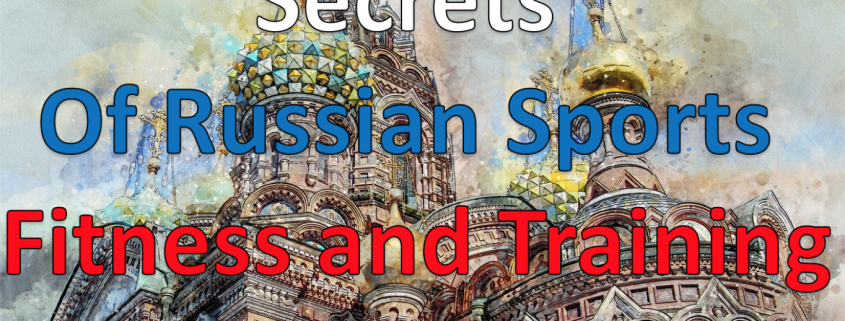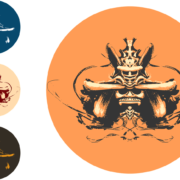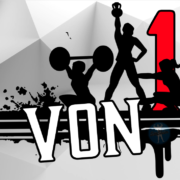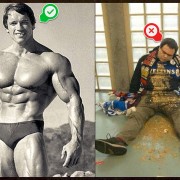Secrets of Russian Sports Fitness and Training (affiliate link) is a book by Michael Yessis Ph.D., that was first published in 1987. About 21 years later this treasure chest of former U.S.S.R. training techniques received an update with addendums of every chapter. Even 30 years after the cold war this book is still hot and drops some massive “knowledge bombs” on every reader! In order to be a good trainer you should stay up to date to recent research. To be a fantastic trainer, who wants to stay ahead of the game, you should also pause and reflect what was done in the past! There is barely anything new in strength training. Therefore I highly recommend you to read this timeless piece of knowledge that can still be implied into today’s training!
Of course it’s hard to narrow all the knowledge of over 300 pages down to only 3000+ words, so please bear that in mind. This article is intended to get you curious to everything you might additionally learn from Dr. Yessis’ book!
Secrets of Russian Sports Fitness and Training – From Russia with Strength
In 1987 it probably was “I spy with my little eye”, when it came to Russian training methods for elite lifters preparing for Olympia.
After the “iron curtain” (great pun) was torn down and almost everybody has access to the world wide web you might ask if there still are Russian “secrets” in terms of strength training…
Well, although you won’t get persuaded by the KGB anymore and besides the fact that there’s no “iron curtain” anymore there is still an “iron game” and as you know you should strike the iron while it’s hot. Let me tell you, even after over 30 years this treasure chest of strength training is still hot as hell!
Let’s reveal a few of the secrets you can find in this book by taking a look at the updated version of the book from 2008:
- How you can benefit from Soviet Sports Techniques
- The Role of Sports in the Soviet Union
- Soviet Sports Research: What It Has Taught The Russians
- The latest Training Innovations: how they can help you
- Speed-Strength Training: A new Soviet Breakthrough
- Maximizing your fitness potential: From Running to Water Sports
- The Soviet science of Sports Psychology
- Nutritional guidelines for improving Performance
- Making the most of Soviet restorative measures
- Drugs in the Soviet sports system
- What’s on the horizon?
- About the author
Over 300 pages of well proven tools and techniques the former Soviet Union used to produce myriads of the finest athletes in history.
The chapters in Dr. Yessis’ book are by no means fairytales form “Mother Russia”, nor are they only anecdotal!
First of all you will encounter lots of the famous Athletes/Coaches from the former USSR, i.e. Dr. Anatoly Bondarchuk , Yuri Verkhoshansky, or Vladimir Issurin, just to name a few.
I first heard about Bondarchuk during a seminar of my mentor Charles R. Poliquin (R.I.P.) who was also known as “Strength Sensei”. Charles told us about the “Bondarchuk Rule”.
According to that there are three types of athletes:
- The ones who best respond to volume
- Those who thrive on intensity
- The ones who benefit most from variation
How you can benefit from Soviet Sports Techniques
The first chapter of “Secrets of Russian Sports Fitness and Training” starts with the difference between American and USSR (now Russian) Athletes, respectively their attitude towards how to approach sportiness itself.
You will learn how Russians empathized the teaching of skills from an early age on but also – in contrast to many misbelieves – saw to it that their youngsters had especially fun, instead of a strict performance oriented approach towards sports!
Dr. Yessis also writes about the difference between pure training for strength and the integration and importance of technique for young athletes. Whereas the Americans foremost tried to produce stronger and stronger athletes, the Russians focused on technique as well.
Chapter one also introduces two important training methods, when it comes to periodization: The Generals Physical Preparation (GPP) and the Specialized Physical Preparation (SPP).
You will learn why the Russians probably have one of he largest body of scientific research on the training of athletes in the world but why even to this day only a fraction is applied by trainers and coaches in the West.
The Role of Sports in the Soviet Union
I think the biggest takeaway of Chapter 2 is the explanation for the Russian Sports dominance (in comparison to the USA) as they developed a training approach called “Conjugate Training”(CT). Let me explain briefly for those who are not familiar with this training technique:
First of all “con/jugate” derives from Latin cum (con) = with, togetherand Latin iungere = to connect, bring together (Becher et al., 1995). So literally translated “conjugate” means “ with a connection” or “something that is brought together”.
According to that, Conjugate Training is the combination of special strength and explosiveness exercises for experienced trainees. CT mimics the movements performed during an actual competition and is also technique oriented as solely a strength maximizing technique.
Therefore special exercises are performed, most likely a “specific key joint action” (Yessis), that resembles the movement of the body during competition, with proper technique and adequate amount of speed (i.e. 0,15-0,20 seconds).
To get the most “bang for your buck” two reasonable exercise have to be combined (a strength exercise followed by an explosive exercise) and they have to:
“(…) duplicate the same action seen in execution of the sports skill. It’s not simply the coupling of any two exercises; they must overlap in their effect” (Yessis, 2008).
A modern approach of CT is propagated by the famous powerlifter Lou Simmons and his “Westside Barbell”. According to them:
“The Westside conjugate system is the best of two advanced training systems: the Soviet system, where several special exercises are used to advance the training of superior lifters and athletes, and the Bulgarian system, where near-max lifts are performed every workout. The Westside system is a combination of the two”. (Westide Barbell, 2020).
Soviet Sports Research: What It Has Taught The Russians
Chapter three and its addendum will give you an idea of Russian sports research. How this knowledge not only came from universities but also “out of the trenches”. A combination of two worlds.
Lots of lecturers at Soviet/Russian universities have always been former athletes, like Dr. Bondarchuk or Verkohansky! Lots of Bondarchuk’s work can be read in depth in his books, like “Transfer of Training” (affiliate link).
Again you find the principle of “conjugate training” but in another field. The Russians didn’t refuse (like lots of US universities did) to integrate knowledge from athletes. They integrated their feedback and combined it with “cutting edge” science from university research!
According to Dr. Yessis, American universities try to stick to old fashioned programs, just because it’s “in the book” instead of integrating practical knowledge from the field.
Moreover their research probands are most likely non athletes, which will make an impact on the results of studies. According to that, Yessis writes that:
“In many cases, the research can be considered “research for the sake of research”, rather than research to learn something new and different or to resolve a particular problem”.
The newest Training Innovations: how they can help you
In a nutshell, Chapter 4’s biggest “secret” is the explanation of Russian Training from a systemically point of view. This Chapter deals with Periodization, GPP and SPP.
Of course I’m not revealing every detail from Secrets of Russian Sports Fitness and Training (Affiliate) but I’ll tell you that you will get an insight how the Russians use periodization and the integration of other sports to get better in their own particular sport.
For example: Dr. Yessis writes how a national volleyball team came to America to face their American opponents. In order to prepare for the game in the evening they spend the afternoon, playing soccer performing deep jumps, squats jumps lunges major hops etc.
This shows how the Russians thought “outside of the box”.
Anecdotal approach: You can apply the Russian’s approach, i.e. if you’re trying to get stronger in bench pressing. Stop bench pressing for a while and focus on your structural balance.
Concentrate on improving your overhead press, as this tends to lag behind. Your overhead press (Behind the neck) should be 66% of your flat bench press.
When it comes to Periodization the Russian split up their year in 4 periods:
- General Preparatory Period
- Specialized Preparatory Period
- Competitive Period
- Transitional Period
Each period had its own special exercises and different volume. For further details I highly recommend reading Dr. Yessis’ book!
Speed-Strength Training: A new Soviet Breakthrough
In 1987 when the first edition of the book was published “Speed-Strength Training” seemed to be some silly approach to US coaches, as they rather stuck to the a rigid mindset. According to Dr. Yessis’ book they thought that “ a lot strength helps a lot” and that “more strength will help the most”…
Meanwhile in Russia something different was figured out. The connection between Speed and Strength. In regard to that, getting stronger, means simultaneously slowing down as your body, respectively your central nervous system (CNS) learns slowness!
According to that Dr. Yessis writes: “Thus, there must be a cutoff point, after which the athlete moves from strength into explosiveness training” (Yessis, 2008). This leads us back to the already mentioned CT (see summary of Chapter 2).
It seems to be essential to build strength in the first place (as a solid foundation) but while progressing in “training age” you have to switch to, respectively integrate speed training as well!
This, again leads us back to Periodization (see summary of Chapter 4). R
Reading Secrets of Russian Sports Fitness and Training (affiliate link) shows you how to think in principles! You will get an in depth insight on how the Soviets/Russians applied their principles and how you can, too…as long as you start thinking in principles!
Maximizing your Fitness Potential: From Running to Water Sports
My biggest takeaway of Chapter 6 was the major difference between US and USSR-Athletes. Whereas the first seemed to “play their sport in order to get in shape” the latter “get in shape to play their sport” (Yessis, 2008).
Another fascinating thing that made me chuckle, was a paragraph in Chapter 6 about Track and Field. In this segment Dr. Yessis writes about how to improve in sprints, respectively in running.
He cites Dr. Mann who concluded that: “elite runners do not fully extend their legs (…) they run in a more upright position than their slower counterparts” (Yessis, 2008). I said it made me chuckle as I immediately thought of Tom Cruise, running in his movies.
You might think of Cruise what you want, but when it comes to death-defying stunts he probably is the greatest daredevil you might have seen on the big screen (except maybe for Evil Knievel).
Next time you watch a Tom Cruise movie pay close attention to biomechanics and his way of running! He ultimately applies what has been done by Soviet Track and Field athletes! Cruise stays almost perfectly perpendicular to the ground while running (instead of leaning forward)!
His arms are bent in a 90° angle and he’s doing rather short strokes! Therefore he doesn’t fully extend his legs while running but seems to rather keep them at an angle of approximately 165° to 170°.
Did Cruise read Dr. Yessis book? I don’t know, but I think Tom is a good example if you like to get an idea of what was done in Track and Field during the Cold War.
Maybe, that’s why Cruise aka “Etahan Hunt” works for the Impossible Mission Force (IMF) and you actually can see him running away from an explosion of the Kreml in Mission Impossible: Phantom Protocol. 😉
Funny marginalia: According to an article of Vanity Fair the success of a Tom Cruise movie is direct proportional to the amount of time he’s running in his movies! (Vanity Fair, 2018).
The Soviet Science of Sports Psychology
When it comes to sports is it really only physical performance that matters? Which role do your thoughts play? Does winning or losing start in your consciousness? Is it rather a mental game that you are playing against an opponent or against yourself?
These are questions that inevitable arise when it comes to sports performance, no matter if you’re a “weekend-warrior” or if you’re performing on a world class level!
In Chapter 7 you will get a glimpse of how the Soviets/Russians dealt with athletes’ pre game excitement, fear, anxiety, intimidation and other stressors that could arguably influence their performance on a competition day!
You will learn about auto-conditioning, meditation techniques and how it is possible to optimize breathing for concentration.
If you like to “aspirate” more about proper breathing techniques for training, feel free to read my article The Oxygen Advantage®. I’m a certified Oxygen Advantage Instructor!
It is a special nasal breathing technique originally developed by a Russian medical Doctor named Buyteko, transferred into the world of physical training and performance enhancement by Irishman Patrick McKeown.
According to Sports Psychology you will also get to know that music may play a great influence on athletic performance and which was used by Eastern-bloc athletes i.e. to produce positive feelings and attitudes to enhance an athlete’s mood and wellbeing.
Nutritional Guidelines for Improving Performance
In Chapter 8 Dr. Yessis writes about nutritional protocols the Soviets used. The Chapter starts with the sentence: “You are what you eat” (Yessis, 1987). That’s one of the things in the book I disagree on. From my perspective you are NOT what you eat, but what you can ABSORB!
So, to get me right, I have nothing against the mentioned protocols and recommendations of the book but from my point of view, working as a Personal-Trainer/Strength Coach and “Heilpraktiker” (complementary and alternative medicine practitioner) I tell you that even the “best” food will do nothing for you if you’re not able to absorb and digest it properly!
Yessis writes that: “Carbohydrates are the basic source of energy that permits muscles to remain active. In fact, certain tissues such as nerves can obtain their energy only from carbohydrates” (Yessis, 1987).
I would like to add something to this statement as research clearly shows that there is no such thing as an essential carbohydrate! Even if you stick to a ketogenic diet, where your main source of energy derives from fats and protein the body has the ability to switch to “gluconeogenesis”. A state in which he converts ketones into sugar to fuel the brain!
In addition to that you will also find in Yessis’ book that Russians seemed to thrive on butter being one of the most easily assimilatable fats! That is still true today even that you have options like MCT-Oils (affiliate link) or native Coconut-Oils (affiliate link) available today which might be absorbed even faster.
A thing that really stuck out in Chapter 8 for me was that even decades ago the Russian recognized that “bulking phases” are merely a nonsense. Gaining weight, just to gain weight isn’t beneficial as you simply accumulate fat.
Excessive fat will “castrate” males, you are feminizing yourself. Testosterone levels will drop, Estrogen levels will rise and inflammation of tissue will rise. You will probably increase your risk for Diabetes Type II, Metabolic-Syndrome and so on.
Making the most of soviet restorative measures
Chapter 9 deals with a really important topic: regeneration. Still today one of the most neglected factors not only in elite athletes. No matter if you use a Soviet approach or the even older Traditional Chinese Medicine one.
For every YIN (energy) you spend you have to put back some YANG in your “energy bank”. Otherwise your output will be more than your input. You don’t need an MBA to understand that this won’t work for a long time!
So make sure you try whatever protocol will suit and benefit you. Whether it’s like the Russians did with massages, sauna, mud baths or what we would call “biohacking devices”. Every workout will either deplete your Central Nervous System or your Peripheral Nervous System.
Both need your attention because hard workouts need hard regeneration. One of the things you really should improve is your sleep! Just to get more “gas in your anti-stress tank”.
Drugs in the Soviet Sport System
Of course this topic has to be spoken about and it inevitably will arise if you think about Eastern-bloc athletes.
If you like to know more about what has been taken and what not, read Yessis’ book. To make a long story short:
Yes, of course they did use substances like anabolic steroids, just like every other athlete did and is still doing in probably every sport in the world.
From my point of view it’s just foolish to assume the opposite. To get me right I DO NOT encourage anybody to take performance enhancing drugs.
But on the one hand society dooms people taking i.e. steroids, on the other it is perfectly acceptable if women take the pill to prevent birth…the pill is a steroid too! If you get a cortisol injection by your medical doctor it is steroids, too…
Just because something is legal by law doesn’t mean it’s good for you either! Think of alcohol, caffeine, nicotine and lots of NSAIDs. All are legal but are they beneficial? Sure, the dosage makes the poison, but just think about it…
What’s on the Horizon
Chapter 11 of the 1987’s version dealt with “cutting edge technologies” the former Soviets had and were up to develop. Of course a lot of what seemed fancy then is our everyday life now.
Of course the Russians nowadays are still sometimes ahead (not only) of the metaphorical game! They are big in every research and at least are still dropping “knowledge bombs” on the world!
About the Author
The book closes with a short summary of Dr. Yessis’ career and an overview about other books he has written. Throughout the book you will also get referrals to blog articles, written by Dr. Y. on his website (doctoryessis.com).
Conclusion
Should you buy Dr. Yessis’ book? Well, I definitely encourage you to do so. No matter if you’re a coach/trainer or if you are just trying to improve your own performance you will definitely find some useful information in this book!
If you are looking for a “secret formula” that will help you to transform yourself from a lazy person into an elite athlete by simply reading this book, you will be disappointed!
But that’s not what a book like this tries to be. It’s more to give you an insight of what was done to realize that there is hardly anything new to resistance training today!
Furthermore, if you’re a coach and you try to stay ahead of others, I think it is always beneficial not to look only for new stuff but also to investigate and imply what was done in the past and what has worked out to be effective for a very long time!
If you liked this article please comment and share it with your friends! Subscribe to the blog and the newsletter!
© HP Bernd Stößlein, Master of Business Administration in Sportmanagement.
Literature
Lateinisch-griechischer Wortschatz in der Medizin, S. 106.
Conjugate Training, source: https://www.westside-barbell.com/blogs/february-2018/conjugate-system, access: 26.02.20.
How good is a Tom Cruise Movie? That depends on how far he runs, source: https://www.vanityfair.com/hollywood/2018/07/tom-cruise-movie-running-ratings, access: 27.02.20.
Cover picture uneditedy by ArtTower on Pixabay.







Dein Kommentar
An Diskussion beteiligen?Hinterlasse uns Deinen Kommentar!